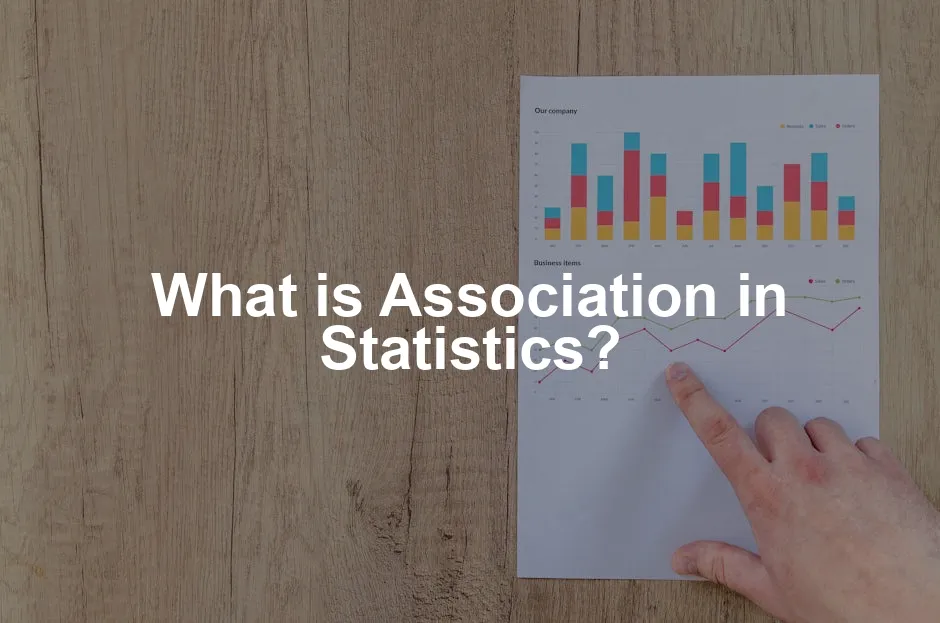Introduction
Association in statistics is like a friendly handshake between two variables. It tells us there’s a relationship, but it doesn’t spill the tea about causation. Think of it this way: if variables were social media influencers, association would be their way of saying, “We’re connected!” But remember, just because they’re hanging out together doesn’t mean one is influencing the other!
Understanding association is crucial for data analysis. It helps researchers glean insights from datasets and recognize patterns. This can be particularly useful in various fields, such as public health, economics, and psychology. However, many people confuse association with correlation and causation. While correlation measures the strength and direction of a linear relationship, association merely indicates that two variables have some sort of relationship. Causation, on the other hand, means one variable directly affects the other.
Picture this: you notice that ice cream sales rise when the temperature soars. Does that mean ice cream causes hot weather? Nope! It’s just an association. Both variables are influenced by a third factor—summer weather. This introduction sets the stage for a deeper look into the fascinating world of statistical association, distinguishing it from correlation and causation.

Summary of Key Points
Association refers to the relationship between two variables, where the value of one variable provides information about the other. This can manifest in various forms and is fundamental in statistical analysis. Unlike correlation, which specifically measures linear relationships, association is a broader term encompassing any relationship between variables.
Understanding the difference between these concepts is vital. Correlation implies a stronger connection, often measured by correlation coefficients, while causation indicates a direct influence of one variable on another. For example, in epidemiology, researchers assess associations to identify risk factors for diseases. In economics, associations can reveal trends related to consumer behavior. For tips on effective data analysis in these fields, check out the tips for effective data analysis in economics and statistics.
Speaking of data analysis, if you’re looking to dive deeper into statistical concepts, consider picking up Statistics for Dummies. It’s a great starting point for anyone wanting to familiarize themselves with the basics of statistics!
Understanding association in various fields helps researchers identify key relationships. Learn more about effective data analysis techniques.
Several methods measure association, including correlation coefficients and contingency tables. Correlation coefficients help quantify the relationship’s strength, while contingency tables display the relationships between categorical variables. Real-world examples of associations can be found everywhere, from the connection between educational attainment and income to the correlation between exercise and overall health.
By recognizing associations, we can better understand how different factors interact in our lives. This understanding sparks curiosity and deeper inquiries into the relationships we observe, reminding us that while two variables may be associated, this does not necessarily imply that one causes the other.

Understanding Association
Definition of Association
What is Association?
In statistics, association refers to a relationship between two variables. When we say two variables are associated, it means that knowing the value of one variable gives us information about the value of the other. This can happen in various ways—sometimes in strong, predictable patterns and sometimes in weaker, more nebulous ones.
In everyday terms, think of association like a friendly connection between two acquaintances. They might hang out now and then, but that doesn’t mean they influence each other’s choices. For instance, if you notice that people who eat more vegetables tend to be healthier, that’s an association. But remember, correlation doesn’t imply causation. Maybe they both just like to jog!
Now, let’s sprinkle in some technical jargon. In a statistical context, two variables X and Y are said to be independent when the occurrence of one does not affect the occurrence of the other. In other words, if knowing X doesn’t help you predict Y, they are independent. If they are independent, there’s no association. However, if X gives you hints about Y, you’ve got an association on your hands!

Types of Association
Positive and Negative Association:
Associations can be positive or negative. A positive association means that as one variable increases, the other tends to increase as well. Imagine the relationship between hours studied and exam scores—more hours usually lead to higher scores.
On the flip side, a negative association means that as one variable increases, the other tends to decrease. Take, for example, the relationship between the number of hours spent on social media and grades. Generally, more time scrolling leads to lower grades. Yikes!
Scatter plots are excellent tools for visualizing these associations. In a positive association, the points on the plot tend to rise from left to right, while in a negative association, they decline. If the points are scattered all over the place with no discernible pattern, it suggests no significant association exists. So, grab your scatter plots and start plotting those relationships!

Statistical Independence vs. Association
Independence Defined:
Statistical independence is a crucial concept in understanding association. If two variables are independent, knowing the value of one variable provides no information about the other. For instance, consider flipping a fair coin. The outcome of the first flip doesn’t affect the second flip. Each flip is an independent event.
Now, let’s clarify this with an example. Imagine you’re analyzing the relationship between the weather and ice cream sales. If it’s sunny, ice cream sales might soar. In this case, the weather and sales are associated. If it’s raining, however, sales might plummet, indicating a strong negative association.
If the weather had no effect on ice cream sales, we’d say they are independent. In such a scenario, knowing it’s a sunny day wouldn’t help you predict sales. So, remember: independence means no association, while association hints at a connection—albeit not necessarily a causal one.
Understanding the nuances of association is vital for interpreting data accurately. As you venture into the world of statistics, keep an eye on these relationships—they can reveal fascinating insights and sometimes even surprises!

Categorical Data Association Measures
Chi-Square Test:
The Chi-Square test is a statistical method used to assess the association between categorical variables. Imagine you’re throwing a party, and you want to know if there’s a link between your guests’ favorite drinks and their age group. The Chi-Square test helps you figure that out!
In essence, it compares the observed frequencies of different categories in your data with the frequencies you would expect if there was no association at all. For instance, suppose you survey your guests and find that 30% of your younger guests prefer soda, while 70% of the older crowd opts for wine. The Chi-Square test evaluates whether this difference is significant or just a happy coincidence.
To conduct a Chi-Square test, you first set up a contingency table, where rows represent one categorical variable (e.g., age group) and columns represent another (e.g., drink preference). The formula for the Chi-Square statistic is:
\[ \chi^2 = \sum \frac{(O – E)^2}{E} \]
Here, O is the observed frequency, and E is the expected frequency under the assumption of no association. A higher Chi-Square value suggests a stronger association between the variables. If your p-value turns out to be less than 0.05, you can confidently say there is a significant association between age group and drink preference at your party!

Contingency Tables:
Creating and interpreting contingency tables is a breeze! Let’s say you want to analyze the relationship between smoking status (smoker or non-smoker) and lung cancer diagnosis (yes or no). A contingency table presents this data neatly.
| | Lung Cancer: Yes | Lung Cancer: No | Total |
|—————-|——————-|——————|——-|
| Smoker | 50 | 150 | 200 |
| Non-Smoker | 10 | 290 | 300 |
| Total | 60 | 440 | 500 |
In this table, you can quickly see how many smokers and non-smokers have lung cancer. To interpret it effectively, you can calculate the proportions. For example, among smokers, the proportion who have lung cancer is:
\[ \text{Proportion} = \frac{50}{200} = 0.25 \quad \text{(or 25%)} \]
For non-smokers, it’s:
\[ \text{Proportion} = \frac{10}{300} \approx 0.033 \quad \text{(or 3.3%)} \]
From this, you can infer that smoking has a strong association with lung cancer diagnosis. To analyze this further, use the Chi-Square test on the data from the contingency table. This combination of visuals and statistical analysis makes it easy to grasp relationships between categorical variables, turning complex data into digestible insights!

Practical Applications of Association
In Medical Research
Association Measures in Epidemiology:
Associations play a vital role in medical research, particularly in epidemiology. Researchers employ association measures to identify potential risk factors for diseases. For instance, when studying the link between smoking and lung cancer, researchers analyze data to ascertain whether a significant association exists.
By utilizing statistical techniques like the Chi-Square test, scientists can determine if the prevalence of lung cancer is significantly higher among smokers compared to non-smokers. This helps in understanding how lifestyle choices influence health outcomes.
Moreover, relative risk and odds ratios are commonly used to quantify the strength of these associations. For example, if smokers are found to have a relative risk of 5 for developing lung cancer, it indicates they are five times more likely to be diagnosed than non-smokers. By recognizing these associations, public health officials can devise effective interventions and promote healthier behaviors among the population.
If you’re looking to expand your knowledge in this area, check out The Data Warehouse Toolkit: The Definitive Guide to Dimensional Modeling. It’s an essential read for understanding data structures and associations!

In Social Sciences
Behavioral Associations:
In the social sciences, associations provide insights into human behavior. Psychologists often rely on associations to understand how various factors influence actions and decisions. For example, researchers may explore the association between stress levels and academic performance among students.
By analyzing data, psychologists can identify trends, such as higher stress correlating with lower grades. Understanding these behavioral associations enables educators to implement stress-reduction programs, helping students achieve better academic outcomes.
Furthermore, associations can reveal insights into societal issues, such as the correlation between socioeconomic status and access to education. These findings can guide policymakers in creating equitable educational opportunities, demonstrating how association measures are crucial in shaping social change.
To support your research efforts, consider using a Data Analysis Software. It can help you crunch numbers and visualize associations effectively!

In Business and Marketing
Consumer Behavior:
Businesses extensively use associations to understand market trends and consumer behavior. By analyzing purchase data, companies can uncover associations between various factors, such as advertising and sales performance.
For instance, if a spike in sales of a new product coincides with a marketing campaign, businesses recognize a strong association. This insight allows companies to allocate resources more effectively, prioritizing strategies that yield positive results.
Additionally, market research often employs association measures to gauge consumer preferences. Understanding how different demographics respond to products can help tailor marketing efforts, enhancing customer engagement and satisfaction. By leveraging associations, businesses can create targeted campaigns that resonate with their audiences, driving growth and profitability.
And if you’re in need of some office supplies to keep your data organized, don’t forget to grab some Whiteboard Markers. They’re perfect for brainstorming and visualizing your thoughts!

Conclusion
Understanding association is crucial across various fields, from medicine to marketing. It allows researchers, psychologists, and business professionals to identify relationships between variables, paving the way for informed decision-making.
However, it’s essential to remember that association does not imply causation. Just because two variables are associated doesn’t mean one causes the other. For example, while there may be a strong association between ice cream sales and warm weather, it doesn’t mean that buying ice cream causes the temperature to rise.
As readers engage with data, they should adopt a critical mindset. Exploring associations can reveal fascinating insights, but it’s important to distinguish between correlation and causation. By doing so, individuals can make more informed interpretations of data, ultimately leading to better decisions and outcomes in various domains.
If you’re looking to enhance your statistical knowledge, consider reading How to Lie with Statistics. It’s a witty and insightful read that highlights the importance of critical thinking in statistics!

FAQs
Please let us know what you think about our content by leaving a comment down below!
Thank you for reading till here 🙂
All images from Pexels




